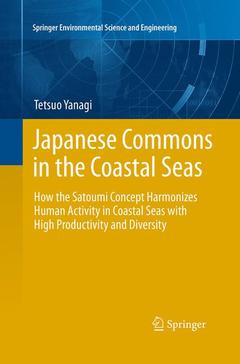Japanese Commons in the Coastal Seas, 2013 How the Satoumi Concept Harmonizes Human Activity in Coastal Seas with High Productivity and Diversity
Auteur : Yanagi Tetsuo

The author proposed the satoumi concept, analogous to the satoyama concept on land, as ?coastal sea with high biodiversity and productivity in harmony with human interaction? in 1998. The concept for environmental conservation in the coastal seas has been widely accepted and was included in the Japanese national policy of ?Strategy for Establishment of an Environmental Nation? in 2007. This book is a translation of the author?s Japanese book (2010) in response to concerns and questions about satoumi, including: Does biodiversity increase as a result of human interaction in coastal seas? Do the economics of fishing villages need to be considered in detail? What legal support is necessary for the creation of satoumi? Is there a relation between the concepts of God and Nature in satoumi? What is the relationship between fishermen and city dwellers? Chapter 1 presents the basic concept of satoumi. In Chapter 2 the relation between biodiversity and human interaction, economic problems related to satoumi, legal support for satoumi creation, satoumifrom the point of view of landscape ecology, and the relation between society and science with regard to the satoumi movement are discussed. In Chapter 3 examples of satoumi creation in Japan are presented, and in Chapter 4 the overseas dissemination of the satoumi concept is introduced, with Chapter 5 providing the conclusion. Chapter 1 presents the basic concept of satoumi. In Chapter 2 the relation between biodiversity and human interaction, economic problems related to satoumi, legal support for satoumi creation, satoumifrom the point of view of landscape ecology, and the relation between society and science with regard to the satoumi movement are discussed. In Chapter 3 examples of satoumi creation in Japan are presented, and in Chapter 4 the overseas dissemination of the satoumi concept is introduced, with Chapter 5 providing the conclusion.
Professor at Kyushu University
Director of the Research Institute for Applied Mechanics
http://www.riam.kyushu-u.ac.jp/english/index-e.html
Gives examples of commons in the coastal sea of Japan
This book serves as a toolkit for the creation of new commons in the coastal sea
Presents a way of sustainable relation for the symbiosis of human and nature
Date de parution : 08-2016
Ouvrage de 113 p.
15.5x23.5 cm
Disponible chez l'éditeur (délai d'approvisionnement : 15 jours).
Prix indicatif 105,49 €
Ajouter au panierDate de parution : 07-2012
Ouvrage de 113 p.
15.5x23.5 cm
Disponible chez l'éditeur (délai d'approvisionnement : 15 jours).
Prix indicatif 105,49 €
Ajouter au panier


